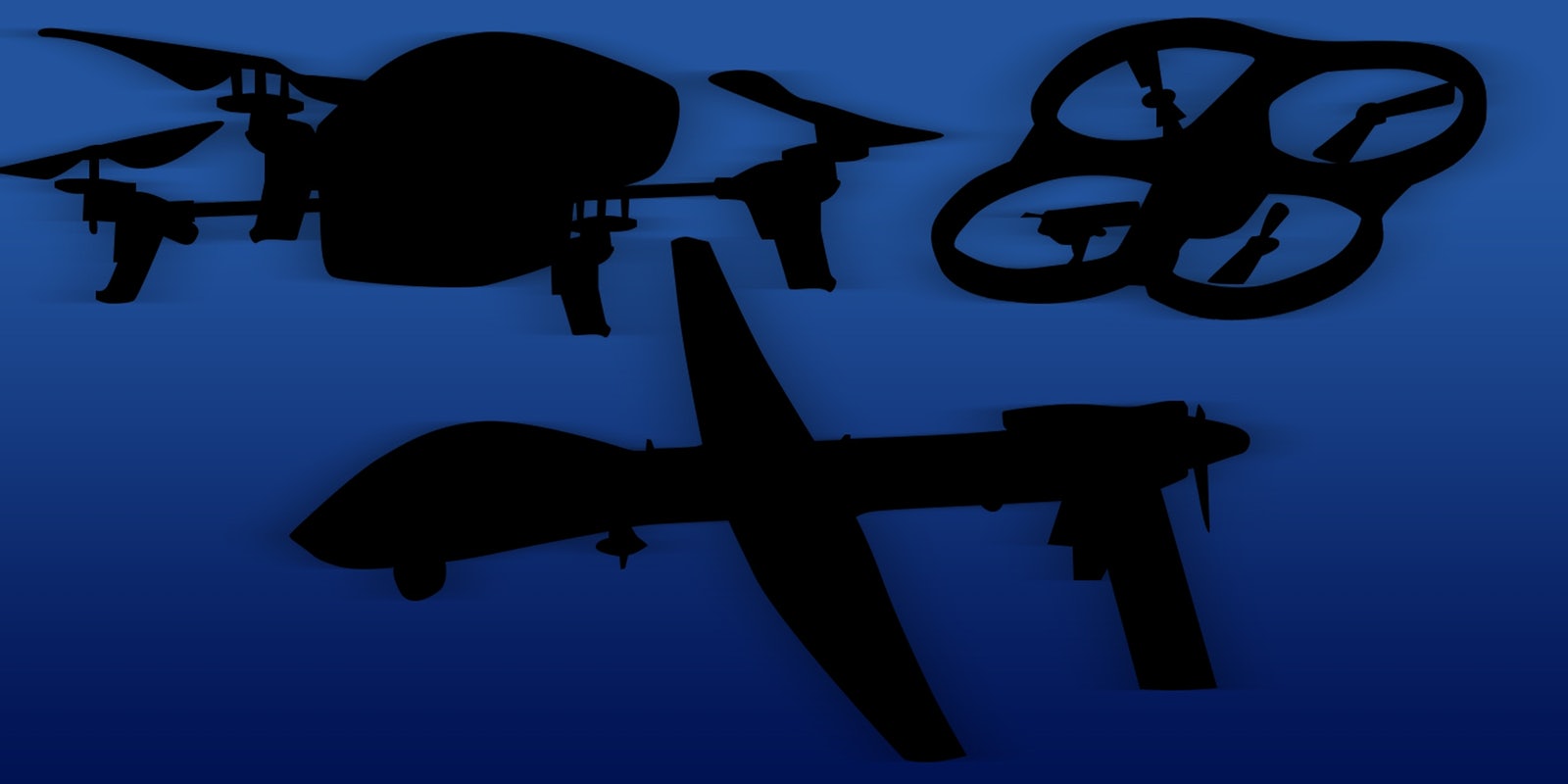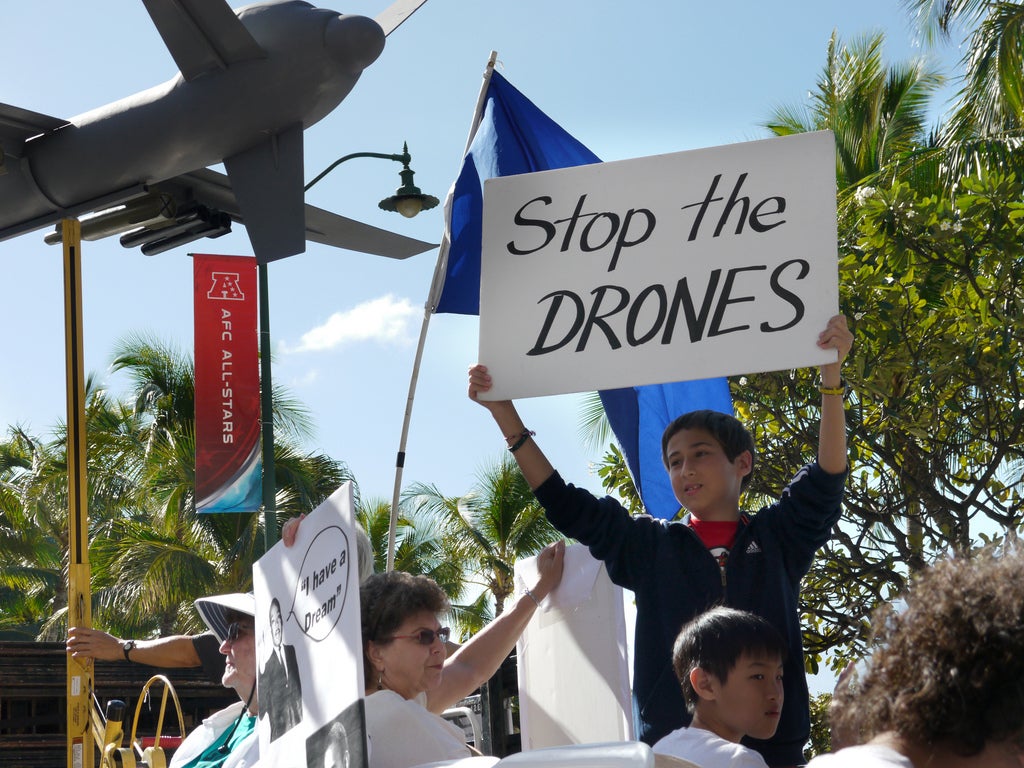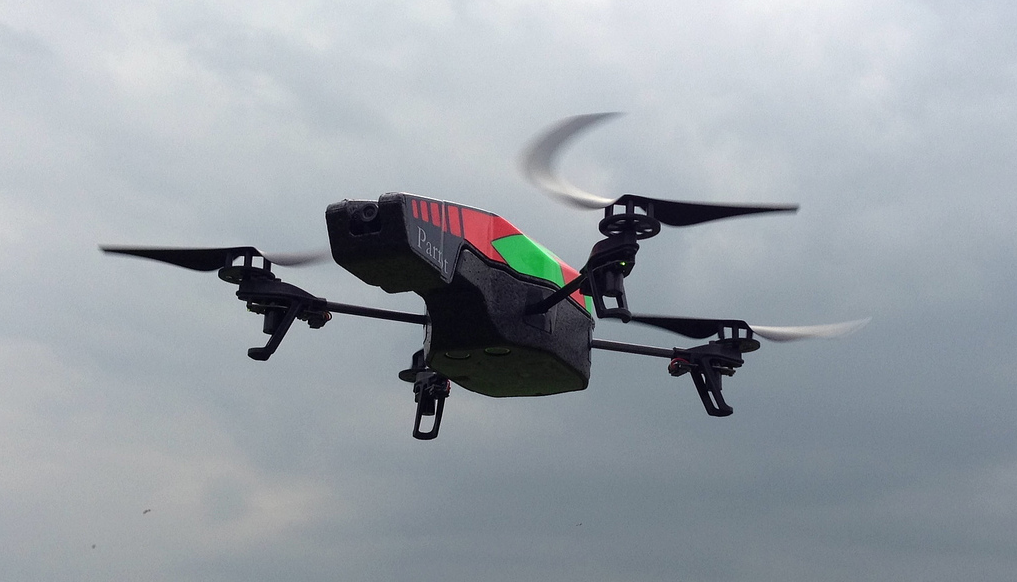From the roof of the Daily Dot’s headquarters, it’s possible to just make out the cluster of skyscrapers of Austin, Texas’s bustling downtown.
If I were to stand atop that roof, snap a photo of downtown, and post it here, I wouldn’t face any legal repercussions. But if I flew a drone up to that exact same spot, took that exact same picture, and then posted it in the exact same place online, I would be breaking Texas’s law against publishing drone photography—unless I could convince the state that I work for a real estate company or the natural gas pipeline business.

I’d also be in violation of Federal Aviation Administration (FAA) rules that the agency claims ban all commercial drone use in the United States. Then again, a recent court decision just cast into question the FAA’s entire ability to regulate drones. Also, the Texas law may be unconstitutional and could crumble to pieces at the first legal challenge.
Confused? Exactly.
Trapped inside of this legal and regulatory tangle is what’s projected to soon become an $89 billion industry with plans to rocket off into a future where drones do everything from deliver prescription drugs to shoot action shots in next summer’s big budget blockbuster.
Until state and federal governments figure out the rules around drones in a reasonable and consistent way, however, anyone attempting to jump on the drone bandwagon will find themselves lost in a maze of confusion.
Behind this regulatory mess is a simple fact: Americans are profoundly uncomfortable with drones. Thanks to the controversial military bombing campaigns in Iraq and Central Asia and the even more controversial domestic spying program, nearly two-thirds of Americans think allowing more drones to fly overhead is a bad idea.
Public safety concerns abound as well. While many of the smaller, low-altitude drones are relatively lightweight, they can still do serious damage—like when an Australian triathlete runner was hospitalized after being hit by a drone that was filming the race. Or the U.K. teenage girl who was killed as a result of being hit in the head with a drone. Or the New York City teenager who died after partially decapitating himself with his drone’s propellers.
Then there’s invasions of privacy to worry about—strangers peeping into the window of private residences to snap intimate photos.
But if you ask drone advocates, like University of Nebraska journalism professor Matt Waite, all they can see is how a small, remote-controlled flying vehicle could solve a whole litany of problems.
Waite first got into drones thanks to a “happy accident,” he says, after he came across “a company offering a fixed-wing plane with a camera on it” at a mapping conference.
“You could use a tablet computer to set a zone for the plane to fly over and then it would go up, take pictures, and assemble them into a single image of the entire area being surveyed,” he says.
Waite’s mind immediately raced through all of the possibilities this technology could unlock, especially how it could enable journalists to quickly and cheaply capture otherwise expensive, hard-to-get images, like the destruction wrought by tornados or the bird’s-eye-view of mass protests like Occupy Wall Street.
?I immediately took out my wallet, handed it to the guy, and said, ?Give me one of those right now,” Waite said with a laugh. ?The guy replied, ?Well, it costs to $65,000 and is illegal to use in the United States.’”
Waite went back to the University of Nebraska and set up the Drone Journalism Lab in 2011, where he guides students through building drone platforms as well as “the ethical, legal, and regulatory issues involved in using pilotless aircraft to do journalism.”
“At the federal level, very little to do with drones is allowed,” Waite noted, adding what leeway does exist makes conducting journalism with drones difficult.
For example, Waite explained, to even get a permit to launch a drone for his program, he has to put in an application with the FAA as much as 60 days in advance. This sort of long lead time makes covering spontaneous, rapidly moving events like natural disasters or street protests legally impossible.
U.S. drone regulation goes back to the years before anyone had heard the term “drone.” Back when the FAA first issued an advisory setting guidelines for their operation in the early 1980s, all that existed were simple model airplanes and helicopters. Those initial rules were entirely voluntary and were simply guidlines for hobbyists—stay under 400 feet and avoid the flightpaths of nearby airports.
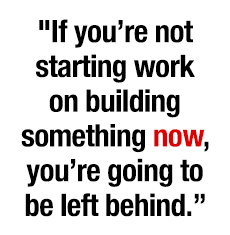
That system stayed in place for nearly three decades, until the FAA issued a statement in 2007 prohibiting the “commercial” use of drones—as in, using drones to make money—within the United States. According to Brendan Schulman, a New York-based lawyer specializing in drone cases, this new policy was initially created as a placeholder to give the agency time to come up with a permanent set rules governing drones. ?Here we are, seven years later, and that still hasn’t happened,” Schulman said.
In 2012, Congress decided to light a fire under the FAA and mandated that it finally implement some more permanent rules about commercial drone use by September 2015.
The FAA has said it plans to release a draft set of rules covering small, lightweight drones by the end of 2014, with full implementation coming about a year later. Schulman remains skeptical.
“It’s clear that the FAA won’t finish by 2015,” he said.
As you might expect, regulating commercial drone use is tricky. When the FAA first issued its prohibition on commercial drone use, its primary target was very large vehicles flying very high up in the air. Smaller, personal drones—also known as unmanned aerial systems (UAS) or unmanned aerial vehicles (UAV)—weren’t part of the agency’s equation.
Since then, the FAA has shifted its focus to the little, nimble drones that typically only go a few hundred feet off the ground. In doing so, the agency realized it had to invent two different sets of rules for two very different types of drones. The change has caused further delay at the FAA, an already notoriously slow-moving bureaucracy.
“The FAA is a safety organization—that’s what they do,” said Schulman. “They take great pride in pointing out that the U.S. has the safest airline industry in the world. It’s a very conservative culture there. That’s why it took so long for people to be able to leave their phones and tablets on during takeoff.”
Despite delays, the agency published a five-year roadmap in late 2013, which laid out its plans for the future. The roadmap indicates that the FAA will likely replace its blanket ban with a comprehensive set of restrictions. The creation of a half-dozen agency-commissioned drone test sites scattered across the country, the first of which just began operation this week, represent the first step in the FAA’s plans to permit some level commercial drone use.
However, the agency has aggressively pursued commercial operations it feels are using drones in violation of federal policy. The government recently cracked down on a nonprofit group called Texas EquuSearch, which has used drones to locate missing people for the better part of a decade.
?Civilian drones are an absolutely irreplaceable resource during our searches,” Texas Equusearch founder Tim Miller said in a statement. “This technology gives us a better chance at finding missing people alive, without the high cost of using helicopters, which are often not even available.”
Earlier this week, the group filed suit against the FAA, claiming that the agency’s efforts to stop Texas Equusearch from using drones lacked legal grounding. In fact, based on a judge’s ruling in a similar case, there’s a chance the FAA’s ban on commercial drone use no longer applies at all.
The case in question centers around Raphael Pirker, one of the world’s foremost drone photographers, who is known for taking breathtaking footage from drone flyovers of the Statue of Liberty and the Golden Gate Bridge.
Pirker’s company, Team Blacksheep, was contracted by the University of Virginia to fly over its campus and take footing for a promotional video. After the initial flight, Pirker uploaded some of the video to YouTube, which attracted the attention of the FAA. The agency slapped Pirker with a $10,000 fine for violating the law and flying recklessly—even though no one was injured and the flight didn’t result in a cent of property damage.
Pirker, who filmed the video using a 5-pound styrofoam drone mounted to a GoPro camera, fought the fine, arguing that the FAA’s 2007 policy memo wasn’t legally binding. The commercial use of drones was never technically illegal, Pirker’s legal team reasoned, because the FAA’s stated set of regulations didn’t carry the full weight of an actual law.
Patrick Geraghty, an administrative law judge for the National Transportation Safety Board, agreed with Pirker and dismissed the fine. Geraghty also agreed that the FAA’s rules were absurdly broad, concluding that the agency was effectively arguing that “a flight in the air of a paper aircraft, or a toy balsa wood glider, could subject the operator to [FAA oversight].”
The FAA immediately appealed the ruling and has stated that it considers its appeal to mean that everything reverts back to the status quo. Because Geraghty effectively decided that the FAA’s rules governing drones have little legal standing, the current state of commercial drone use remains a massive question mark.
With federal drone laws in flux, state legislators have taken the matter into their own hands, primarily crafting laws aimed at protecting their citizens from being spied on by drones. Nine states have passed legislation restricting drone use, and four more have similar laws under consideration.
Most of these laws aim to prevent law enforcement from using drones to collect information on citizens without a warrant. But a few states have taken a very different, much more restrictive, approach. Idaho and Texas have both imposed bans on publishing photos taken by drones without first getting the consent of every single person in the photo, plus permission from the landlord of each and every building pictured.
The Texas law contains a litany of exemptions, for everything from real estate agents to police officers. There are no exceptions in the Texas law for journalists or for private citizens practicing drone photography for non-commercial purposes.
Georgia state representative Harry Geisinger is a co-sponsor of a proposed bill that’s a virtually carbon copy of the Texas law. He explained that the goal of the legislation is to stop bad actors from invading citizens’ privacy.
“Our bill doesn’t keep people from using drones,” said Geisinger. ?It just makes sure that if someone uses one to take a picture of someone or something they shouldn’t, they’re going to get in trouble for it. This isn’t going to restrict anybody from using drones.”
Geisinger admits he hasn’t heard much from his constituents on the issue, but he predicts drones will become a massive growth industry relatively soon. He notes that he’s heard of movies filming in the state employing drones to get aerial shots that would be otherwise difficult to capture, and he believes it’s important to get rules in place before the technology become ubiquitous.
Both Waite and Schulman are skeptical that bills like the one proposed by Geisinger will hold up in court.
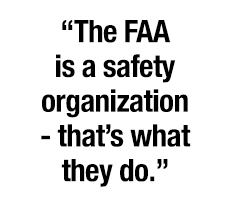
?The Supreme Court has affirmed that there’s no expectation of privacy on a photograph taken from the air in places where planes tend to fly,” explained Schulman, who represented both Team Blacksheep and Texas EquuSearch in their respective lawsuits against the FAA.“There’s a First Amendment right to take a photograph of someone in a public place and that right is enhanced if the picture is for a journalist purpose. These laws don’t seem to have taken that into account and that’s where there are grounds to challenge them.”
“If you’re banning someone from taking a photo in a public place, that’s fine. But you better make a really good case as to why it’s necessary, or else the law is going to go down,” Waite added.
This legal chaos hasn’t stopped the rise of drone-based businesses. A prime example is QuiQui, a San Francisco-based startup that plans to deliver prescription drugs using drones before eventually branching out into the delivery of a slew of other goods.
“Ideally, we want to become the FedEx of autonomous delivery,” says QuiQui founder Josh Ziering.
He admitted that the regulatory environment for drones isn’t as friendly as it could be, but the company is intent on pushing ahead anyway.
“If the FAA moves too slow, we may end up using the Uber model by just starting to make deliveries and have the regulators come to us,” Ziering says. “I don’t think anybody knows how the regulations are going to shake out. But, if you’re not starting work on building something now, you’re going to be left behind.”
Illustration by Jason Reed | In-copy photos: Photo via World Can’t Wait/Flickr (CC BY 2.0), photo by Andrew*/Flickr (CC BY-SA 2.0),

